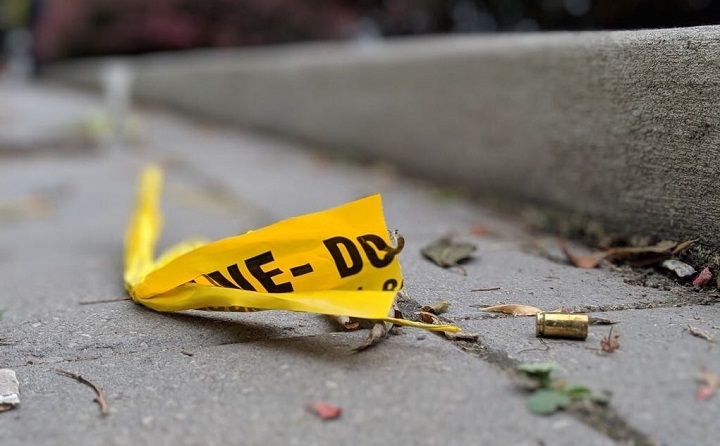

By
Andrew Russell &
Tracy Tong
Global News
Published May 19, 2022
9 min read

On Sept. 22, 2018, Canadian Border Service agents seized a vehicle attempting to cross from New York.
Inside the vehicle, a so-called “trap” compartment secreted 20 firearms, including several .40 calibre Smith & Wesson handguns, 9mm Taurus pistols and a silencer. Court documents show the individual driving the vehicle was a Canadian citizen.
The firearms were traced to Southern Florida where more than two dozen handguns were purchased from gun shows and stores between 2018 and 2019, the U.S. Justice Department said. Mackenzie Delmas, 27, was sentenced to almost 20 years in federal prison for smuggling firearms, U.S. justice officials said.
The details from that seizure, and many others across the U.S., are vital to understanding how violence on Canadian streets unfolds.
Yet, there is no national database on the origins of Canada’s so-called crime guns, meaning there is still no broad view of where these firearms might be coming from.
New data, obtained by Global News, offers a rare glimpse of the flow into Ontario: Between 2018 and 2021, five states were the top sources for crime guns in the province.
The data, based on successful firearms tracing from the Criminal Intelligence Service of Ontario, shows Ohio is the top U.S. source of its crime guns, with 170 traced back to the Buckeye State in 2021.
Texas has become a leading source with 160, and Florida was third with 159. Georgia accounted for 129 and Michigan with 59.
The limited data does not contain numbers related to traces on domestic crime guns or the total number of guns traced.
Amid a rise in shootings in major Canadian cities, a Global News investigation traced the path of a single firearm used in two killings, to show how factors like U.S. gun shows, straw purchasing, and soaring black market prices for guns continue to contribute to violence across the border.
In a recent Ohio case, a criminal network was procuring handguns from private sales and gun shows — at least 200 of them — which were destined for the Greater Toronto Area, according to U.S. court documents.
The guns, which were bought between 2018 and 2019, were smuggled across the border in Toyota Camry sedans, a popular car among criminals as its empty space near the centre console is favoured for hiding guns or money, according to the U.S. Bureau of Alcohol, Tobacco, Firearms and Explosives (ATF).
Some of the handguns were purchased for $500 and could be resold in Canada for up to $5,000, authorities said at the time.
Both the Florida and Ohio cases — like many others in the U.S. and Canada — highlight the problem of straw purchasing: when someone is paid to buy guns in their name, but then turns them over to another party.
A dozen of the guns in the Ohio case were later seized by police in Toronto, Peterborough, Thunder Bay, Chatham Kent and Peel, according to a Toronto police source, who was not authorized to speak publicly about the case.
It’s an indication of how one trafficking case can affect multiple communities.
The cases also reveals how U.S. gun shows are a key source for criminals looking to supply Canada’s black market. There is minimal paperwork between private sellers, and handguns can be bought at a fraction of their retail price, authorities on both sides of the border say.
It’s a different process from Canada, where handguns require both a possession and acquisition licence (PAL) and an additional restricted firearm licence. The whole process can take two to three months.
However, there have also been instances of Canadian citizens buying handguns domestically to resell on the black market — especially in western provinces, police say.
Chris Taylor is an agent with the U.S. Federal Bureau of Alcohol, Tobacco, Firearms and Explosives (ATF) and is the attaché for Canada. He works closely with Canadian police agencies in Ottawa and across the country to tackle gun smuggling at the border.
While he says that the ATF has “no opinion” on gun shows, firearms tracing can help lead investigators to the source of where multiple guns are being purchased at one time, with Canadian streets as a final destination.
“It allows us to identify the source and the retail purchases of these firearms, and whether they come through a gun show or any other source,” Taylor said.
“It closes the loop between the first purchaser and how it wound up at a crime scene in Canada.”
It’s unclear why Ohio leads all other states in boosting Ontario’s supply of crime guns. Experts say it could be the lack of specific laws regulating private sales of firearms and proximity to Canada.
But whether it’s Michigan, Ohio, Florida, Georgia, one connection between these five states is a major highway: the I-75, which runs from the tip of Florida up to the Great Lakes. Investigators said they are still investigating why Texas has become a top source state.
“There’s obviously a possibility that guns are coming up from those states through the I-75 corridor and right into the underbelly of Ontario,” ATF agent Taylor said.
Global News went to Michigan to get a look at how firearms are both purchased from stores and inside gun shows.
Just over a 20-minute drive north of Detroit, Action Impact Firearms & Training Center sits on 8 Mile Rd. in Eastpointe, Mich., surrounded by auto repair shops, payday loan stores and fast food chains.
Inside the store, rows of Glocks, Sig Sauers, and Taurus handguns are neatly shown in glass display cases. AR-15 rifles and shotguns are lined up behind the counter.
The pop of rounds being fired at a range can be heard echoing in a separate part of the building.
Action Impact’s Bill Kucyk, a firearms instructor and former police officer, is no stranger to handguns.
He regularly shoots and encourages people to enroll in one of his firearms training course.
Otherwise he won’t sell you a gun.
“It’s not required by law, it’s my business practice. I’m not sending you out into your community with this gun in front of your family, if you have no clue what you’re doing,” he told Global News.
Buying a long gun in Michigan comes with basic requirements: minimum age of 18, a state resident, U.S. citizen and no prior felony convictions, for starters, according to state laws. Handguns are slightly different. The minimum age is 21, and the owner needs to register it with the state of Michigan.
After filling out some paperwork and a call to the FBI for a background check, a firearm transaction can be completed fairly quickly, he said.
“The quickest I could probably do a firearm transfer is 20 minutes,” he said. “Assuming you know what you’re doing and you can read and write.”
Gun shows are a different story, said Kucyk.
“If a citizen is selling to citizen, none of the requirements that I have to meet are there,” he said, noting with handgun sales, pistol records are still supposed to be completed. “They can just go, ‘Here’s a gun, give me the money.’
“They don’t even know who they’re selling to.”
Held at a convention centre or at venues as small as American legion hall, gun shows are held regularly across the U.S. where handguns and long guns are plentiful and significantly cheaper than in a store.
An AR-15 at a gun store could run between USD$1200 – $2,000. At a Michigan gun show Global News attended, a used AR-15 could be bought for $500-600.
Handguns, which can range in price from $500 to over $1,000 in stores, were being sold for $200-400.
“All you need is a Michigan driver’s licence and be 18,” a vendor could be heard saying at a gun show in Lansing.
Michigan ATF Special Agent in Charge Paul Vanderplow said a buyer is required to fill out an ATF Firearm Transaction Record asking if they are a U.S. citizen, if you’re the actual buyer of the firearm, and if you’re a convicted felon, among other criteria.
But some people will simply lie.
“It’s called lying and buying. Where persons will purchase firearms, knowing that they will turn it over to somebody who shouldn’t have it,” he said, noting it can come with a 10-year sentence. “Maybe for a fee, maybe to pay off a debt or a host of reasons.”
The Toronto Police Service have said that 85 per cent of the city’s crime guns are arriving from the U.S., but there is no national data, despite years of calls for better statistics. In Western Canada, police services in Alberta or B.C. have pointed the finger at domestic sources.
“If we increased tracing in Alberta and British Columbia and Saskatchewan, you may see additional routes discovered to maybe Idaho, California, Nevada,” said ATF agent Taylor.
“Canada has a domestic trafficking problem too… but without tracing, we are unable to identify the source of the crime guns turning up in Canada, whether they’re domestically sourced or internationally.”
Researchers and experts have for years pointed to a dearth of data on the source of where Canada’s illegal guns are coming from.
In 2020, Statistics Canada announced that it was launching a project with police services to increase the amount of information collected on guns used in crime, but it is unclear when the data might be released.
A spokesperson for StatCan said the project is now complete and that its Uniform Crime Reporting Survey — designed to measure the incidence of crime in Canada — is now able to better capture “information on the number of firearms recovered, seized or stolen in a criminal incident.”
“It should be noted that it may take a few years for all of these changes to be fully implemented by police services in a way that allows the reporting of this information to the UCR Survey,” said Kathleen Marriner in an email.
The Canadian Centre for Justice and Community Safety Statistics is also working on a feasibility study focusing on “expanding crime gun tracing efforts by Canadian law enforcement and collecting more comprehensive data.”
“It is anticipated that the final feasibility report will be completed by October 2022,” Marriner said.
For agents at the ATF or other experts studying illegal firearms trafficking, better tracing and improved publicly available data on the sources of illegal guns are crucial tools to stopping violence.
“Follow the path and follow the firearm, and maybe it’ll lead to the person or persons who were at that crime scene,” ATF special agent Vanderplow said.

Comments